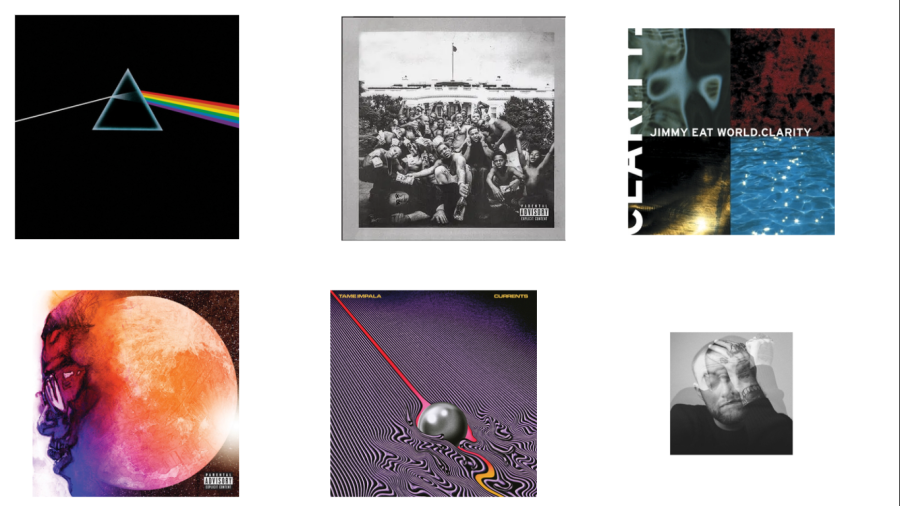Deriving Emotional Fulfillment from an Album
May 1, 2023
One of the most powerful motivators, a portal to realms unreachable by normal human bounds, and a close friend that accompanies you on your best and worst days – this just gleams the tip of the iceberg for what music is for us. Something so abstract, so formless yet so vivid, eludes me. I’ve recently decided to embark on yet another artistic voyage to articulate where we derive beauty from, this time focused specifically on full-length musical albums. I interviewed a student at Roosevelt who is extremely musically inclined and a teacher at Roosevelt who is much less musically inclined to see how their answers would vary. As a massive fan of full-length albums, I also did some self-reflection to figure out what I believed makes a full-length album great.
When I think of albums that I have an intimate emotional connection with, my mind goes straight to The Dark Side of the Moon (DSOTM) by Pink Floyd. An ethereal and hauntingly beautiful sound, the hypnotically wistful lyricism, and the sleek flow from song to song in terms of theme and musicality are elements of this album that make the listening experience so meaningful. I still remember my first listen to “The Great Gig in the Sky” because of how shaken I was after hearing borderline angelic vocals by Clare Torry, equipped with a passion unmatched by any songs I had ever listened to in my life. On slower lyrical tracks like “Breathe in the Air” and “Us and Them”, Roger Waters’ eerie and melancholic vocals, backed up by a phantasmic guitar and a melancholic saxophone respectively, create an atmosphere of ever so intimate dread. Hearing Waters softly mutter “Hanging on in quiet desperation is the English way” on Breathe in the Air was just one of the many beautiful poetic moments in DSOTM. And to wrap it all up and make the listening experience truly amazing, the songs all connect together – both in an auditory sense and a thematic sense.
The album’s biggest theme is the inevitable and unstoppable passage of time that leads us all to a common and imminent demise. In the instrumental track “On the Run”, the brief voice of Pink Floyd’s manager, Roger Manifold, can be heard stammering “Here today gone tomorrow” which then leads to a rapid increase in tempo and decrease in auditory stability as the atmosphere reels in the listener, making it feel as though we are fearfully running for our life from tomorrow along with the song. Time explores the passage of time through the eyes of a regretful cynic, who describes their life as “waiting for someone or something to show you the way”. I still remember the first time that I heard the line “And then one day you find, ten years have got behind you” and it was yet another lyrical sword that pierced my heart with a feeling that I knew all too well. The finale to DSOTM is Eclipse, which serves as a portal that connects the album together into one perfect loop, ending on the sound of a heartbeat that Speak to Me/Breathe, the opener, begins with. Listening to this album was and will continue to be one of the greatest experiences I have ever had.
When I asked senior Joey Bailor what he believed made listening to an album great, his mind immediately went to an album’s coherence. Bailor highlighted a distinction between good and great albums in that “any album can have a good song or a few good songs,” but his favorite albums have music that “perfectly compliments itself”. This is similar to how I believe one of the qualities that make DSOTM so great is its continuity from song to song. Another facet of great albums that Bailor harped upon was how they “explore a central theme in bold and creative ways” with each song bringing in “a new perspective” or “addressing different parts of this theme” without ever feeling out of place together. Finally, Bailor affirmed that emotional connection was essential to developing intimacy with an album. To Bailor, a great album “inspires you to feel intensely”, through either “amplifying an emotion you are already familiar with” or “taking you on an emotional journey. One of Bailor’s most cherished albums, Nevermore by Nirvana, exemplifies these characteristics heavily.
AP, Science and Tech, and Honors Chemistry teacher Mr. Brian Stagg’s outlook on what makes an album great slightly differs from Bailor’s perception. Mr. Stagg’s favorite album, which is Clarity by Jimmy Eat World, takes him back to his high school days. For Mr. Stagg, nostalgia is what makes an album great – the portal to humble beginnings and simpler times. Places that we can’t drive to or fly to are only accessible through this music. His favorite song of the album, Crush, specifically brings Mr. Stagg back to “senior year and driving to the bowling alley”. Taking swift passage into the time machine that is Clarity for Mr. Stagg leads to this faraway yet intimate land, the door to Narnia or the train station to Hogwarts. This perspective gave me an entirely renewed appreciation for music, as I had overshadowed the emotional connection that memories and songs can have for the fundamental characteristics that make the identity of the album.
Through three different yet kindred examinations of what makes an album great, I have come to the conclusion that a great album is cohesive, explores themes past their surface level while retaining homogeneity, and amplifies emotions that nothing else in life can.




